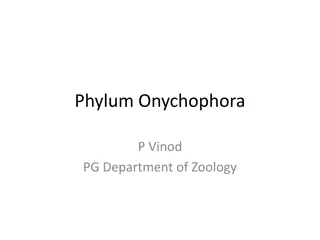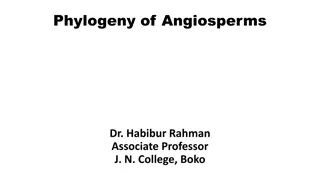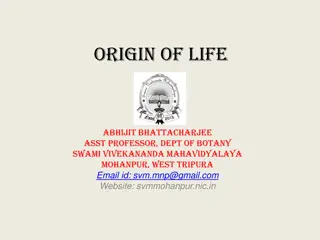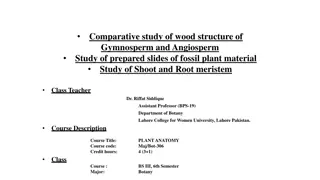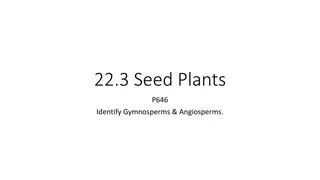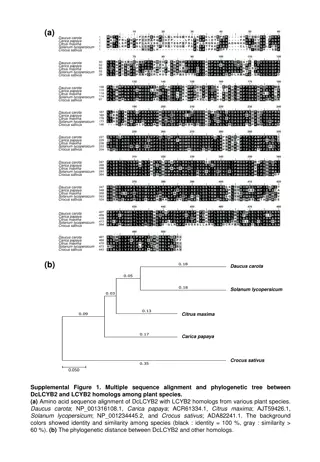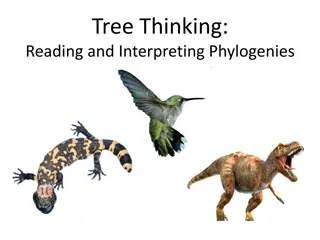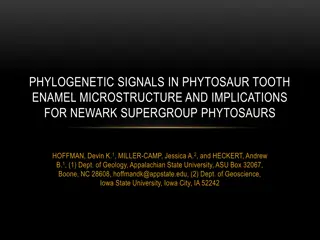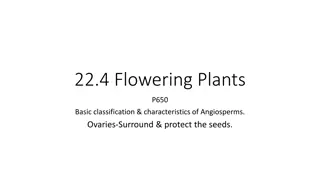Origin and Evolution of Angiosperms: Insights into Their Phylogenetic Origins
Undisputed fossil records reveal the significant appearance and diversification of angiosperms during the Mesozoic era. The debate on the origin of angiosperms revolves around their monophyletic versus polyphyletic nature. While some argue for a monophyletic origin based on shared characteristics, others support a polyphyletic origin suggesting divergent evolutionary paths for dicots and monocots. Recent phylogenetic analyses shed light on the relationships within angiosperm families. This comprehensive study by Dr. Gyanranjan Mahalik delves into the fascinating world of angiosperm evolution from a historical and molecular perspective.
Download Presentation

Please find below an Image/Link to download the presentation.
The content on the website is provided AS IS for your information and personal use only. It may not be sold, licensed, or shared on other websites without obtaining consent from the author. Download presentation by click this link. If you encounter any issues during the download, it is possible that the publisher has removed the file from their server.
E N D
Presentation Transcript
Origin and evolution of angiosperms Module-III B.Sc 4th sem. By Dr. Gyanranjan Mahalik Asst. Prof. Dept. of Botany; SoAS Centurion University of Technology and Management
Undisputed fossil records place the massive appearance and diversification of angiosperms in the middle to late Mesozoic era. Angiosperms ( seed in a vessel ) produce a flower containing male and/or female reproductive structures. Fossil evidence indicates that flowering plants first appeared in the Lower Cretaceous, about 125 million years ago, and were rapidly diversifying by the Middle Cretaceous, about 100 million years ago. Earlier traces of angiosperms are scarce. Fossilized pollen recovered from Jurassic geological material has been attributed to angiosperms. A few early Cretaceous rocks show clear imprints of leaves resembling angiosperm leaves. By the mid-Cretaceous, a staggering number of diverse, flowering plants crowd the fossil record. The same geological period is also marked by the appearance of many modern groups of insects, including pollinating insects that played a key role in ecology and the evolution of flowering plants. Angiosperms are monophyletic (i.e. a group consisting of all descendants derived from a single ancestor) or polyphyletic (i.e. a group that does not have a common ancestor). Due to inadequate fossil records, the question of phyla of the angiosperms still remains unsolved. However, angiosperms are a natural group and contain characters, which make them unique from all other vascular plants.
(a)Monophyletic Origin: i. As a group, the angiosperms have typically been viewed as being monophyletic. However, no definite fossil evidences are available in favour of the monophyletic origin. This view is based on the fact that present-day angiosperms show remarkable consistency in their characters, i.e. presence of sieve tubes in all, uniform staminal structure, characteristic endothedial layer of the anther wall, double fertilization, and formation of triploid endosperm, which are considered defining features of angiosperms and support the monophyletic grouping. ii. The monophyletic origin of angiosperms is also supported by Hickey & Doyle on the basis of their studies of mono-sulcate pollen. iii. Dahlgren believes that the ancestor of the present-day angiosperms was a gymnospermous member.
(b) Polyphyletic Origin: i. Several phylogenists including Cronquist, Hughes, Games, Krassilov and Meeuse have argued that the angiosperms are polyphyletic i.e. dicots and monocots originated from different primitive stocks at different times, and attained their present status through parallel or convergent evolution. ii. The theory of polyphylesis is also supported by the fossil records of variety in perianth and the nature of carpel in both dicots and monocots. iii. The polyphyletic origin of angiosperms is further supported by the fact that primitive orders of both the monocots and dicots do not show any close relationship in their characters. Thus fossil records suggest that angiosperms, as a group, are monophyletic, and their families or groups of families are polyphyletic. However, recently, phylogenetic analyses using nuclear, mitochondrial, and plastid gene sequences have aided in clarifying relationships between the various angiosperm families. The monocots and eudicots are each supported as being monophyletic. The angiosperms as a whole were found to be monophyletic to the exclusion of the gymnosperms.



